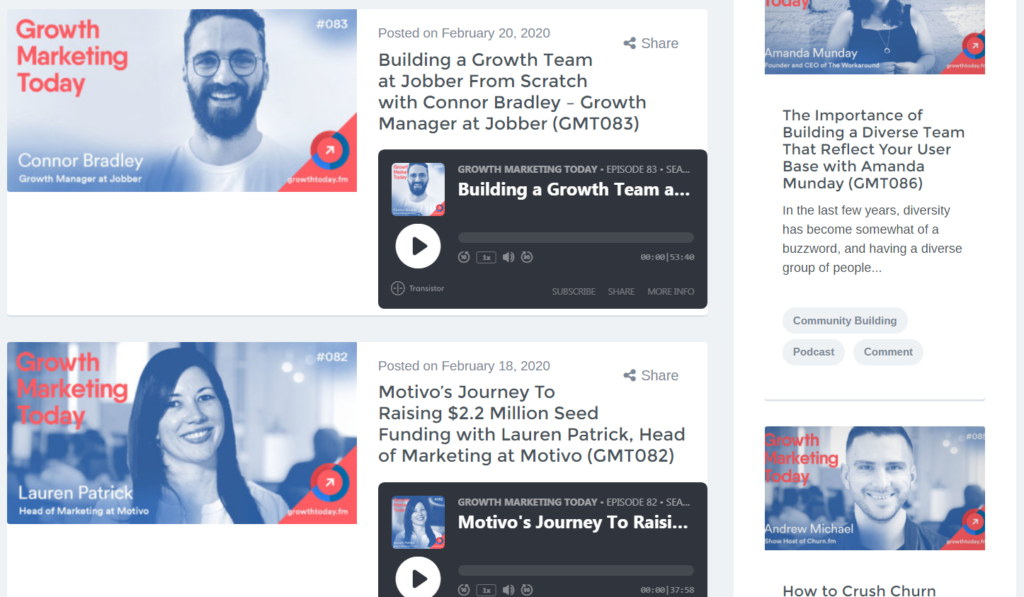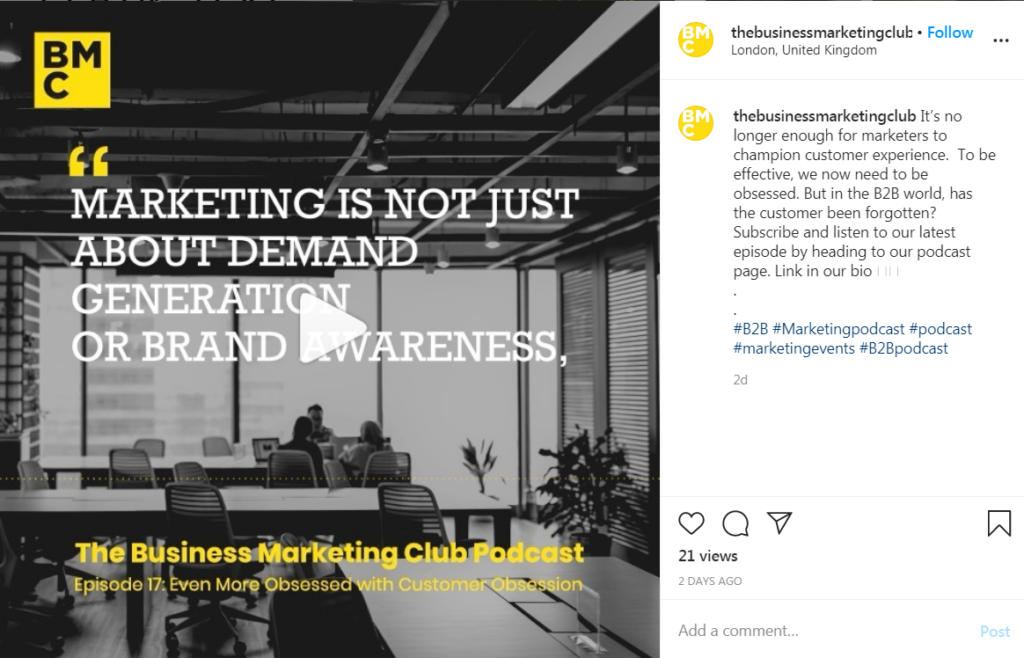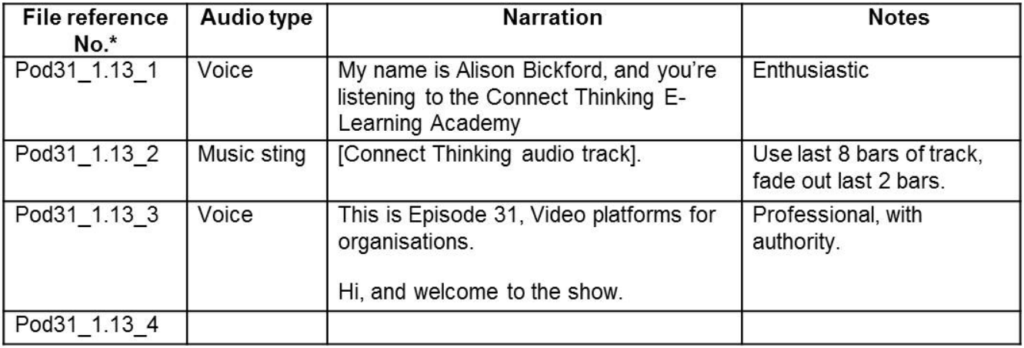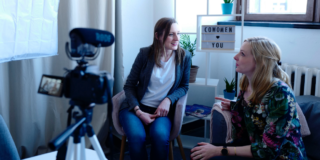If you’re an active podcast listener, you likely use popular podcast platforms (i.e. “podcatchers”) like iTunes, Soundcloud, and Google Podcasts to download or stream one of more than 1 million podcasts available today.
This article is a podcast roadmap to get you from passive listener to active host. I’m sharing my learnings as a five-year podcast co-host and agency owner who has helped develop podcast strategies for clients.
Podcasting is affordable, relatively easy to produce, and provides access to an engaged listener base. According to Edison Research, 80% of users listen to most of each episode, averaging 7 per week, while 69% of listeners agree that podcast ads make them aware of new products or services.
Brands have jumped on the podcasting bandwagon. Slack, GE, Shopify, Basecamp, and Sephora all have large, active followings.
Podcasts’ popularity means opportunity—and competition. If you don’t have a thoughtful strategy and process, it’s easy to waste time and effort. Let’s get started.
Table of contents
Podcasting as a marketing channel
Podcasting technology dates to the early 2000s. The first shows were created in late 2003, and the term itself was coined in 2004 by combining “iPod” with “broadcasting.”
Later that year, former MTV VJ Adam Curry adopted the phrase, and it became popular when he launched his own podcast, Daily Source Code.
Validation for the medium, however, occurred when Apple provided support on its iTunes platform. The rest is history.
While global brands have seen success with podcasting, it’s easy to attribute that success to funding and momentum. Not every brand has the budget or a large audience of potential podcasters ready to listen.
But podcasting does have a lower cost and barrier to entry than video (at least quality video production). You can have guests on your show without requiring their physical presence, which saves money and is a useful workaround for times like these.

Podcasting can drive traffic to a website, which, in turn, can generate leads or sales. Some marketers may also benefit by refining speaking and interviewing skills in a lower-risk environment than on a stage.
My personal interest in podcasting, however, is how it dovetails beautifully with voice search. Consumers can now listen to podcasts via simple voice commands and pause to ask Google, Siri, or other digital assistants questions inspired by the podcasts.
Those questions provide brands an opportunity to be the “best answer”—connecting casual listening behavior to, potentially, company or product research.
Start with a business objective
I’m a strong believer in not jumping into a technology, channel, or media format just because everyone else is doing it. As with any marketing effort, a podcasting program should start with a foundational alignment to marketing or business objectives.
Podcasting, by design, is ideal for generating awareness and building thought-leadership in your industry. While it can generate more tangible results, other channels are usually more effective.
Once objectives are identified and prioritized, your podcasting plan should outline strategies and tactics, which include format, frequency, duration, host/s, point of view, guests, research, syndication, and marketing.
We dive deeper into each topic below.
Upfront costs: The hardware and software you need to start a podcast
Unlike professional-quality video, the start-up costs for podcasting are quite affordable. The key hardware components include:
- Condenser microphone;
- Mic stand;
- Headphones;
- Sound mixer;
- Hosting;
- A place to record, which should include acoustic panels or fabric to isolate sound.
While it’s technically possible to start podcasting with a smartphone for free, investing in the proper hardware and software is highly recommended. A bare-bones DIY setup with an affordable mic, stand, mixer, headphones, and acoustic panels for a sound box starts around $75.
A mid-range setup, including condenser mic, stand, upgraded mixer, acoustic panels (for a makeshift recording room) and Adobe Audition CC software will run $150 and up.
For a professional-grade setup, including a dedicated studio, you should expect to spend $750 (not including talent, studio rent, or acoustic paneling).
Hosting options for your podcast
Beyond hardware, the most essential tech component is finding a quality hosting solution. Hosting fees range from free to $99/month, but the most common starting point will run about $20/month for reasonably robust management and reporting.
We often recommend Libsyn to our clients. Libsyn pricing starts at $5/month for up to 50MB (about 50 minutes of show time), but I recommend the $20/month package for advanced reporting, which is essential for anyone interested in generating revenue from advertising or sponsorships.
Other platforms have similar pricing and features. Take some time to comparison shop.
Most hosting sites charge based on monthly usage, but some are based on lifetime data allowances. Podcast hosting sites allow you to upload podcasts directly, including descriptions and thumbnails.
From there, podcatchers (i.e. podcast directories) pick up and syndicate your podcasts for free via RSS feeds. Popular podcatchers include, but are not limited to:
- iTunes;
- Stitcher Radio;
- Spotify;
- Google Play Music;
- Podcast Addict;
- CastBox;
- Pocket Casts;
- DoggCatcher Podcast Player;
- Podcast Go;
- TuneIn Radio.
Podcast production
Regardless of content format (audio, video, text, or print), branding is essential. The podcast creative and voice should be authentic and consistent with your brand.
Your podcast content and format should be unique. Show descriptions should be intuitive but also keyword-loaded.
Consistency maximizes credibility. Commit to a season at a time, not one show at a time. Lastly, design matters. Create a compelling show logo and episode thumbnail design with consistent yet unique show titles.
Thumbnail images or logos should be 1400×1400 pixels for iTunes and podcatchers. Specifications are available online, and 99Designs does a good job with its podcast cover design guide.
Selecting a podcast host
Unless you can afford to hire Joe Rogan or Dr. Phil, it’s unlikely that you’ll make the list of the most popular podcasts right out of the gate.
The next-best thing is to find a known influencer or expert within your industry to host your podcast—if you can work out a deal that makes sense.
Short of that, use professional voice talent that has a soothing yet modulating tone. Most commonly, however, show hosts are passionate or knowledgeable about a given topic and thus work for free or at low cost as a hobby. This can still be true in a company, particularly with experienced or enthusiastic staff.
While previous experience is helpful, it’s not required, though hosting takes practice. To balance “on air” experience with industry knowledge, consider co-hosts.
For DadsUnplugged, the podcast I co-hosted, I was the “foil” to my co-host, who drove a Prius, meditated, and tried every modern parenting tactic available. Our personalities balanced each other well, and it more than doubled the “perspective” brought to the show.
Podcast format, frequency, and duration
Content is only as good as the format in which it’s delivered. Make sure you’ve created a structure that works for the host(s), guests, marketing, and the production team.
Based on your overall objective, host talent, and resources, you’ll need to finalize show format, frequency, and duration.
Format. One of the biggest questions is whether you’ll have guests. Well-known guests can help with marketing exposure, and interviews tend to fill air time easily. Drawbacks include up-front coordination and the increased likelihood of connectivity or tech issues.
Additional formats include creating segments (news vs. commentary) and live audiences. (While less common, live audiences can increase the energy of the show and attract higher profile guests.) Try out a few different formats in the first season (6–12 shows) and refine based on fit and feedback.
For best results, start with a storyboard or outline. This provides an opportunity to talk through the most important elements of the show, including segment timing and transitions.
Consider mapping out the show with minute marks, like the professionals. If needed, create a script for your hosts and questions for your guests (ideally provided in advance).
Segment the show if it’s longer than 10 minutes. The standard late-night TV talk-show format can be a guide:
- Introduction/monologue;
- Feature segment;
- Guest interview.
Make sure you have a strong open and close that includes calls to action like subscribing, sharing a link to your website, thanking sponsors, or reminding interested parties to advertise on your podcast (if relevant).
Frequency. The most common podcast format is weekly, but some shows are daily; others are monthly.
Duration. The most common duration ranges from 10 to 22 minutes, but daily podcasts may run 1–5 minutes. Monthly shows may run 60–90 minutes.
Post-production tips
Don’t forget the small elements that provide polish, like introductions or transition music (check out Serial for inspiration).
From a big-picture perspective, podcasting provides an opportunity to repurpose content. Whether it starts as video or audio, it can be turned into images, text, and other forms.
There are other benefits to thinking long term, even if your podcast doesn’t make it to a second season. Consider, for example, archiving your podcasts for free via YouTube.
Beyond saving monthly hosting fees for old podcast episodes, YouTube offers an opportunity to reach a global audience. (It’s the third largest search engine behind Google search and Google Images.) Include a compelling thumbnail as a visual element to support your podcast audio on YouTube.
Bonus content is king of the podcast world, so consider recording your podcasts with a digital camera (DSLR) or camcorder from Day 1. You’ll have native video and images ready for YouTube, Instagram, Pinterest, and other platforms.
Even without video, you can easily create bonus content by including additional audio (that may not have made the final cut) as well as an accompanying blog post, article, or even print collateral (resource lists, checklists, etc.) to support the show.
Podcast distribution
Creating a compelling podcast is only half the battle—you still need to find listeners. One of the most effective methods is to optimize and syndicate your podcast to podcatchers.
To support distribution, the show title should be unique, memorable, relevant, and, of course, keyword optimized. Next up is the show description. Make it detailed yet intriguing (and, again, keyword infused).
One element podcasters typically don’t spend much time thinking about is the show category. The trick is to balance topical accuracy with maximum visibility.
For example, my old show covered a variety of topics about parenting and fatherhood, and each show was posted under multiple categories based on the theme (e.g., comedy, education, health & fitness, kids & family, sports, etc.).
Most podcasts pick a category and stick with it, but flexible show formats may consider unique categories for each podcast.
Podcast promotion
Google, like humans, prefers context with its content. Transcribing your shows is affordable, easy, and—with minimal effort—can be formatted into a long-form article or summary blog post.
Syndicate the blog or episode summary page via social media in addition to syndicating a link to a podcatcher or host site.

When syndicating each episode on social media, use hashtags, especially for Twitter, Instagram, and LinkedIn. Beyond industry-specific language, consider podcast-specific terms like #podcast, #podcasting, #podcastguest, or #instapodcast.

- For visual platforms like Instagram and Pinterest, use behind-the-scenes images or video as teasers for upcoming (and archived) episodes.
- For YouTube, create playlists that arrange relevant episodes sequentially.
- Boost posts on platforms like Facebook and consider testing a targeted ad campaign to grow your subscriber base via Google Ads.
- For business-related podcasts, post teasers and episodes to LinkedIn, as well as supporting them with targeted advertising.
- Explore a pay-per-conversion affiliate program for referring site traffic that results in listeners, especially if you’re trying to generate revenue from your podcast.
Advertising can grow your listenership quickly and influence visibility on podcatchers. Generating significant listens in the first 24–48 hours can help earn a spot on iTunes’ New & Noteworthy section, for example.
Many podcasters forget marketing fundamentals when promoting podcasts:
- Remind listeners to support you with calls to action.
- Incorporate a link to your latest podcast or episode page in your email signature.
- Promote episodes in your newsletter and on your homepage, and create a dedicated section on your website.
- Provide pre-made promos to guests and partners to maximize reach.
A more advanced strategy is to identify and engage “super listeners” (evangelists) with special incentives to promote your show. You may also want to explore cross-promotional opportunities with other podcasters/shows.
Monetizing a podcast
If you want your podcast to generate revenue—not just be a marketing expense—you have a few options, depending on objectives, audience, competition, format, and talent.
Advertising and sponsorship revenue can cover costs, if not create a livable wage. Corporate marketers should be able to pull from the existing budget to cover start-up hard costs ranging from $150–1,500 (if not push for a full studio rental or even build-out).
A smart way to finance a podcast, or even a career, is to secure sponsors or advertisers. This can be tricky, however, without an existing podcast and listeners to sell against. Consider investing in the start-up costs and hosting a half-dozen foundational shows before reaching out for investment.
- Sponsorships are typically customized and based on personal relationships, so they’re easier to secure earlier in the development of a show.
- Advertising is typically managed by a network like Midroll or AdvertiseCast, which means you’ll need listener data (sometimes 10,000 listeners minimum) to get picked up by a network.
Don’t want to start a podcast? You can still take advantage of their marketing potential
One of the lowest-cost alternatives to hosting a podcast, while still generating awareness via audio channels, is to secure guest spots on industry podcasts.
It’s one of three ways to get some of the same benefits without the investment:
1. Be a podcast guest. I’ve been both a one-time guest on higher profile podcasts like the NutraCast Podcast and a regular (monthly) guest on Mr. Social Entrepreneur.
Benefits of guest appearances on podcasts include low time commitment, little-to-no cost, plus getting to reach a larger existing audience.
2. Sponsor podcasts. The second alternative to hosting your own podcast is to sponsor existing industry podcasts. Podcast sponsorship rates vary, as you might expect. According to AdvertiseCast, average sponsorship rates are $18 CPM for a 30-second ad and $25 CPM for a 60-second ad.
3. Partner with others. A third option is to create a strategic partnership with knowledge, technology, or resource experts within your community or industry.
For example, C’est What? is run by a futurist, professional speaker, and author who asked us for help marketing his podcast, Craving the Future. We connected him with a professional voice recording studio for his second season, resulting in exponentially higher quality for the finished product.
Another example is closer to home. I don’t have a background in radio or broadcast, despite my experience as a co-host. I also have no first-hand experience with editing or producing podcasts. As a result, my agency partnered with Milepost Media to create Podcast for Closers.
My second round as a podcast co-host has been more informative and productive, as both agencies co-sponsor the podcast series and benefit from the exposure.
Conclusion
While this article is comprehensive, podcasting shouldn’t appear daunting.
Creating a podcast—like every other content marketing effort—requires some investment of time and money to do it right, but it’s far more affordable and approachable than video.
With self-distancing, remote working, and quarantines top-of-mind, audio branding is as relevant as ever.




